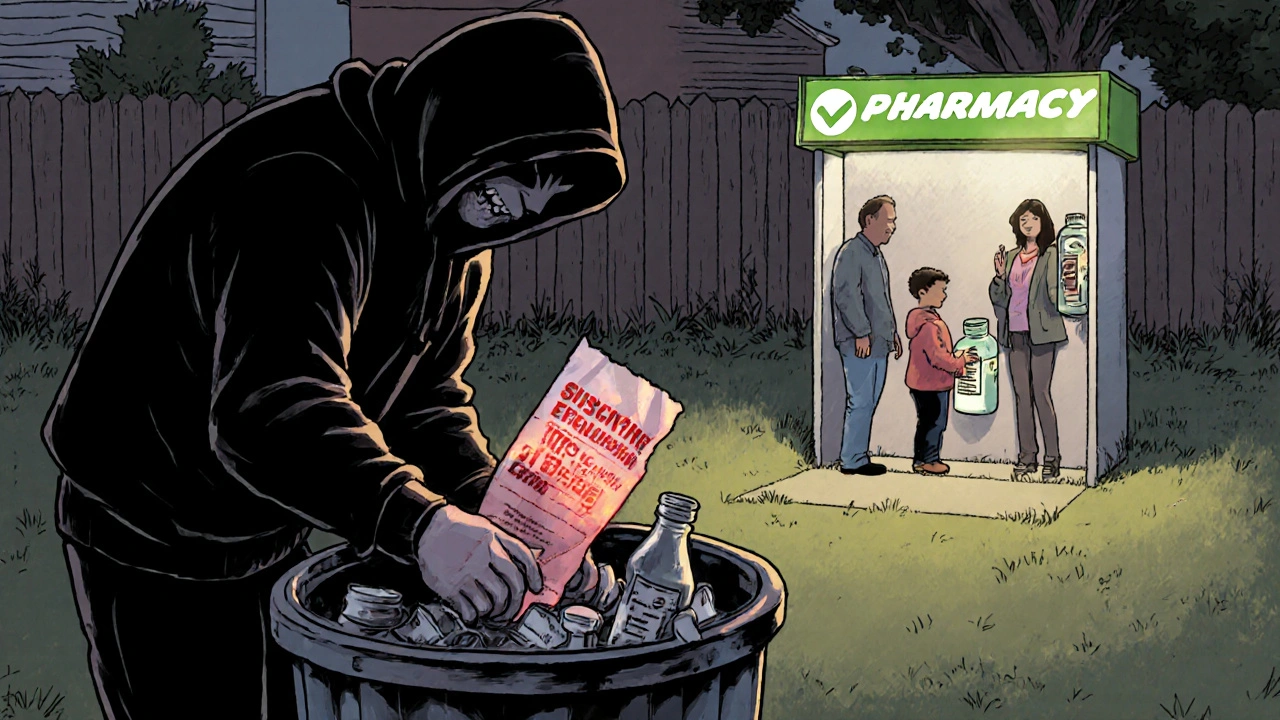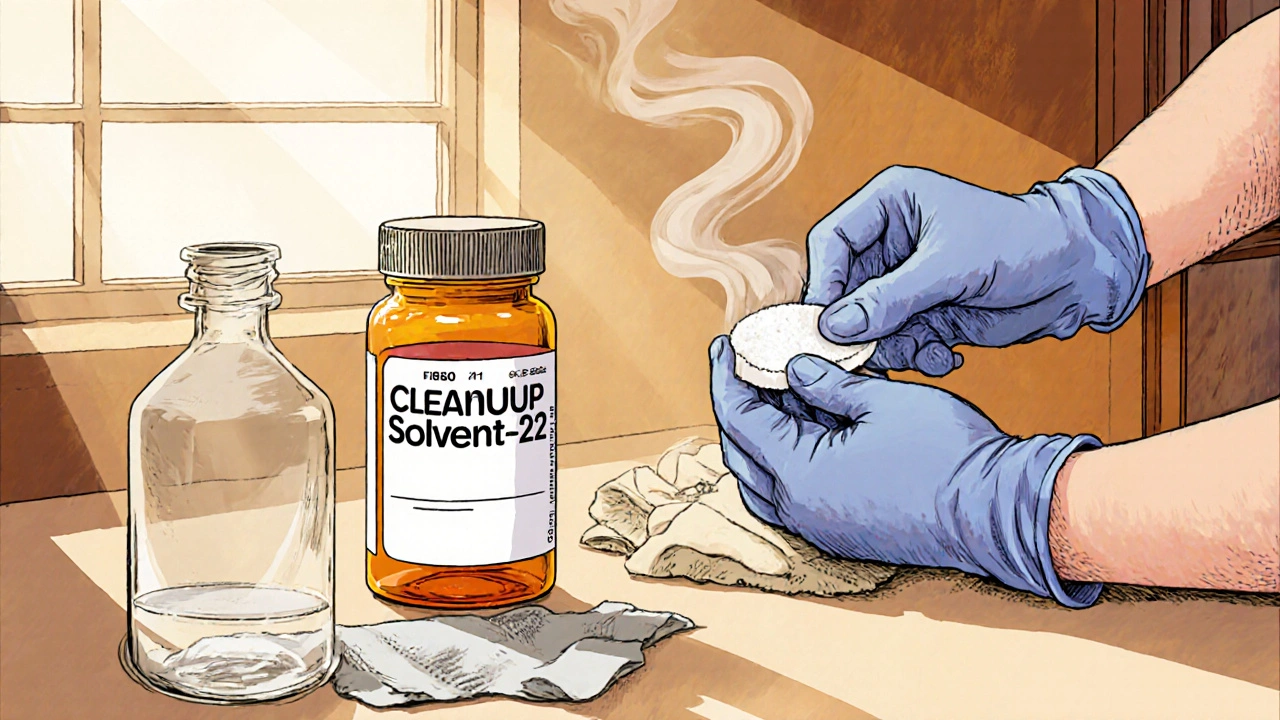When you finish a prescription, you might think tossing the empty bottle in the trash is harmless. But that little plastic container holds more than just leftover pills-it holds your name, address, birth date, doctor’s name, condition, and even your pharmacy’s phone number. All of it. And criminals are actively hunting for these bottles. In 2021, over 412,000 cases of identity theft in the U.S. were tied directly to prescription labels, according to the U.S. Department of Justice. These aren’t just random breaches. Someone can use your name and prescription details to get controlled drugs under your identity, file fake insurance claims, or even open credit accounts in your name. The Federal Trade Commission lists prescription labels as one of the top five sources for medical identity theft. And it’s not just a U.S. problem. Similar risks exist in the UK and across Europe. The solution isn’t complicated, but it’s often ignored. You must destroy the personal data on the label before you throw the bottle away.
Why Simply Peeling Off the Label Doesn’t Work
Most people try to peel the label off by hand. It seems logical. But modern prescription bottles use waterproof acrylic adhesive that’s designed to stick permanently. When you peel it, you’re not removing the data-you’re leaving behind a sticky, readable mess. Titan Labs tested this in 2022 with 500 bottles. In 92% of cases, the adhesive residue still contained full patient information. Even if you scrub it with water or soap, the ink doesn’t wash off. The data stays. And with a smartphone camera and free photo-enhancing apps, thieves can recover the text from smudged or partially peeled labels. Reddit users reported that 89% of manual peeling attempts failed to fully remove readable data. Don’t rely on this method. It’s a false sense of security.The Best Method: Chemical Dissolution
The most reliable way to remove labels without leaving data behind is using a solvent designed for the job. One product, Cleanup Solvent-22, uses a safe, acetone-based formula that breaks down the adhesive in 15 to 20 seconds. Here’s how to do it:- Put on gloves and work in a well-ventilated area-solvents can smell strong.
- Apply the solvent directly onto the label. Use a cotton pad or paper towel to soak it in.
- Wait 15 to 20 seconds. The adhesive will soften and release.
- Gently peel the label off. If any residue remains, wipe it with a clean cloth.
- Wash the bottle with warm soapy water to remove any leftover solvent.
What If You Can’t Get a Solvent?
Not everyone wants to buy a special product. If you don’t have access to Cleanup Solvent-22 or similar, the next best option is using a permanent black marker. But you have to do it right. Simply scribbling over the text won’t work. In 2023, CHOC (Children’s Hospital of Orange County) tested this method and found that 63% of blacked-out labels still showed recoverable data under infrared light or smartphone filters. Here’s how to do it properly:- Use a Sharpie Permanent Marker or equivalent.
- Apply three thick, overlapping layers of ink across every word on the label.
- Let it dry for at least 30 seconds.
- Hold the bottle up to a bright light. If you can still see any letters, numbers, or symbols, go over them again.

Shredding Is an Option-But Only for Trash
If you’re not keeping the bottle, shredding it is the most thorough way to destroy the data. But you need the right tool. Regular paper shredders won’t cut plastic. You need a cross-cut shredder designed for hard plastics. Companies like LegalShred.com offer this as a service, but it’s not practical for most households. Some local pharmacies and waste centers have drop-off bins for safe disposal. CVS and Walgreens started installing label-removal stations in 2020, and many now offer free take-back programs. Check with your local pharmacy-they might have a bin or a day when they collect old bottles.What Not to Do
There are several common but dangerous myths about removing labels:- Soaking in vinegar: CHOC testing showed a 78% failure rate. Vinegar doesn’t dissolve acrylic adhesive.
- Using a hairdryer: Heat might soften the glue slightly, but it leaves the label warped and still readable. Success rate: only 63%.
- Just throwing it in the recycling: Recycling centers don’t remove labels. Your data could end up in a landfill or be collected by someone else.
- Waiting more than 24 hours: Javelin Strategy found that delaying label destruction increases identity theft risk by 40%. Do it the same day you finish the medicine.

What About the Bottle Itself?
If you remove the label cleanly, the bottle is safe to reuse. Many people repurpose them for organizing small items: pills, beads, screws, or even first-aid supplies for travel. Just make sure the label is completely gone. Hold it up to the light. If you see any text-even faintly-go back and re-treat it. Some pharmacies now offer bottles with UV-erasable ink, but those are still rare. For now, manual removal is your best bet.Why This Matters Beyond Privacy
Identity theft isn’t just about stolen credit cards. In 2023, the average cost per victim was $1,347, according to Javelin Strategy. That’s not just time lost-it’s money, stress, and damaged credit. Medical identity theft can lead to incorrect medical records, denied insurance claims, or even being flagged for drug abuse because someone used your name to get opioids. The DEA and FTC both stress that patients share responsibility for protecting their data. HIPAA protects your records at the pharmacy, but once the bottle leaves their hands, it’s your job to make sure the data doesn’t fall into the wrong hands.Final Checklist
Before you toss any medication bottle, follow this quick checklist:- Remove all pills and rinse the bottle.
- Apply solvent (preferred) or black marker in three thick layers.
- Wait for it to dry or dissolve.
- Peel or wipe off the label completely.
- Hold the bottle to the light-no text should be visible.
- Dispose of the label separately from the bottle if shredding.
- Do this within 24 hours of finishing the medication.
If you’re unsure, take the bottle to your local pharmacy. Many now have free disposal kiosks with tools built in. It’s the easiest way to make sure your data is gone for good.
Can I just throw away my old medicine bottle without removing the label?
No. Leaving the label intact puts your personal information at risk. Identity thieves regularly go through trash looking for prescription bottles. Even if the bottle looks empty, the label still contains your name, address, medical condition, and prescription number-all the details needed to commit fraud. Always remove or destroy the label before disposal.
Is using a black marker enough to hide my information?
Only if you use it correctly. One layer of marker isn’t enough. You need three thick, overlapping layers covering every letter and number. Even then, some data can still be recovered under infrared light or with photo-enhancing apps. For maximum security, chemical removal is better. But if you can’t get a solvent, three layers of permanent marker is the FTC’s accepted backup method.
What’s the best product to remove prescription labels?
Cleanup Solvent-22, made by Titan Labs, is the most tested and effective product for this job. It breaks down the waterproof adhesive on prescription labels in under 20 seconds without leaving residue. It’s affordable, works on all common plastic bottles, and leaves them clean for reuse. You can buy it online for around £12. Other solvents like acetone or nail polish remover may work, but they’re less reliable and more dangerous to use indoors.
Can I recycle my empty medicine bottle after removing the label?
Yes, but only if the label is completely gone. Many recycling programs accept plastic bottles, but they require them to be clean and label-free. Even a small piece of adhesive or ink can contaminate the batch. Wash the bottle thoroughly after removing the label, then check your local recycling rules. If in doubt, take it to a pharmacy with a take-back program-they’ll handle it safely.
Why do pharmacies offer label removal stations?
Because they’re legally and ethically responsible for protecting patient data-even after you leave the pharmacy. With over 400,000 identity theft cases linked to prescription labels in 2021, pharmacies like CVS and Walgreens started installing label-removal tools in 2020 to help customers dispose of bottles safely. These stations often include scrapers, solvents, or shredders. It’s their way of reducing risk and helping you protect yourself.
What should I do with the actual medication before destroying the bottle?
Never flush pills down the toilet or throw them loose in the trash. Mix them with something unappetizing like used coffee grounds, kitty litter, or dirt in a sealed bag. This makes them unappealing to pets or people who might go through the trash. Then dispose of the bag before you tackle the bottle. The FDA and DEA both recommend this method to prevent accidental ingestion or misuse.
Are there any new technologies to make this easier?
Yes, but they’re not widely available yet. Companies like McKesson are testing RFID-enabled bottles that automatically erase data after 30 days. Pfizer has also trialed UV-erasable ink that fades in sunlight. But these are still in early stages. For now, manual removal is the only reliable method. Don’t wait for future tech-act now. Your data is at risk today.
